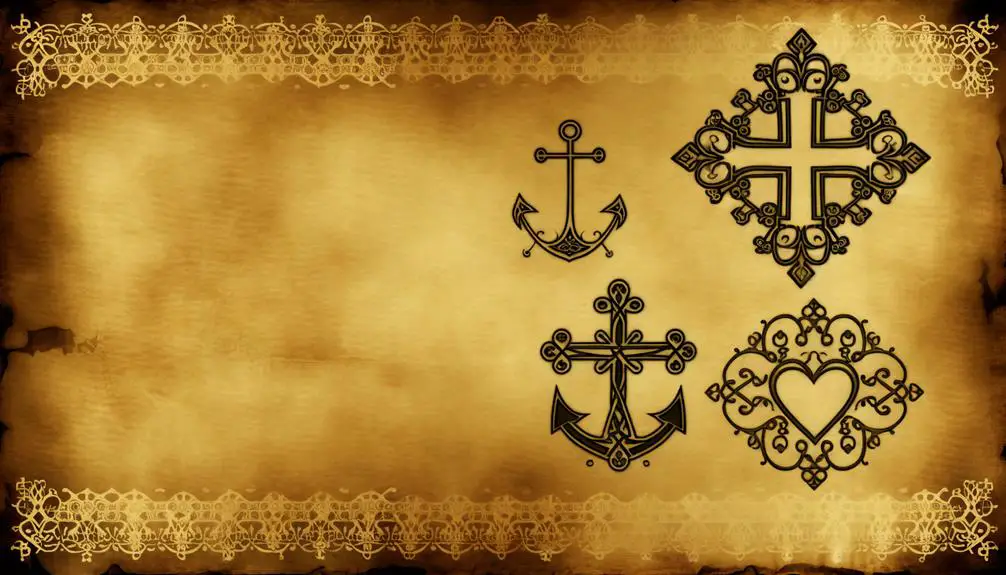Symbols of Faith Hope Love
The symbol of Faith, Hope, and Love has profound origins in early Christian theology, prominently emphasized by the Apostle Paul in 1 Corinthians 13:13. Faith is often symbolized by the cross, representing trust and divine belief.
Hope is depicted as an anchor, signifying steadfastness and future aspirations. Love, universally represented by the heart, embodies divine and human compassion.
These symbols are deeply ingrained in religious texts, literature, and art, reflecting pivotal Christian virtues that have both historic and contemporary significance. Exploring these symbols further reveals their transformative power and timeless relevance in both spiritual and societal contexts.

Key Takeaways
- The Faith, Hope, and Love symbol often incorporates the cross, anchor, and heart, representing each virtue respectively.
- These virtues originate from Apostle Paul's teachings in 1 Corinthians 13:13, central to Christian theology.
- The symbol reflects enduring moral and emotional narratives, deeply ingrained in religious texts, art, and traditions.
- Modern interpretations expand these virtues to include trust in humanity, sustainability, inclusivity, and global unity.
- Artistic expressions use these symbols to evoke spiritual connections and emotional responses, enriching personal and communal experiences.
Historical Background

The origins of the Faith, Hope, and Love symbol can be traced back to early Christian theology, where these virtues were extensively discussed in scriptural texts such as the New Testament. Especially, the Apostle Paul in 1 Corinthians 13:13 emphasized the preeminence of these virtues: 'And now these three remain: faith, hope, and love. But the greatest of these is love.'
This tripartite concept gained significant theological prominence, serving as a cornerstone for Christian ethical teaching. Patristic writings further reinforced their importance, viewing them as integral to spiritual growth and moral conduct.
The synthesis of these virtues into a single symbol reflects their intertwined nature and enduring influence, encapsulating foundational Christian ideals in a concise, emblematic form.
Symbol of Faith
The symbol of faith, prominently represented by the religious cross, holds profound theological significance as it encapsulates the essence of Christian belief in salvation and divine grace.
Beyond its religious connotations, the cross also inspires faith in humanity, serving as a universal emblem of hope, endurance, and moral integrity.
Analyzing these dimensions reveals the multifaceted nature of the cross as a symbol that transcends mere iconography to embody deep spiritual and ethical principles.
Religious Cross Significance
An abiding symbol of Christianity, the religious cross embodies the deep and selfless faith central to the religion. Historically, the cross symbolizes Christ's crucifixion, an act seen as the supreme offering for humanity's redemption. Scripturally, it represents themes of reconciliation, deliverance, and divine love. The cross's importance is varied, evident in theological, liturgical, and personal aspects of faith.
| Aspect | Symbolism | Scriptural Reference |
|---|---|---|
| Reconciliation | Sacrifice for sins | Romans 5:8 |
| Deliverance | Promise of eternal life | John 3:16 |
| Divine Love | God's unconditional love | 1 John 4:9 |
This emblem remains a widespread indicator of the enduring and transformative power of faith.
Faith in Humanity
Faith in humanity, a profound symbol of faith, underscores the inherent belief in the goodness and potential of individuals to contribute positively to society. This conviction is not merely idealistic but is rooted in historical and contemporary examples where collective human effort has surmounted adversity.
Scriptural texts, such as the Bible's emphasis on loving one's neighbor (Mark 12:31), echo this faith, urging communal harmony and altruism. Analytical perspectives suggest that such faith fosters social cohesion and resilience, enabling societies to navigate crises effectively.
Symbol of Hope
In Christian iconography, the anchor often serves as a profound symbol of hope, representing steadfastness and endurance amidst life's trials. This imagery is deeply rooted in scriptural references such as Hebrews 6:19, which speaks of hope as 'an anchor for the soul, firm and secure.'
The anchor's symbolism can be analyzed through three key aspects:
- Stability: The anchor prevents drifting, signifying spiritual stability amidst the tumult of life's challenges.
- Expectation: It represents a forward-looking confidence in divine promises and the ultimate salvation.
- Perseverance: Anchors illustrate the enduring strength required to hold fast in turbulent situations.
These facets underscore the anchor's role in embodying hope as a crucial component of Christian faith.
Symbol of Love
Among the myriad symbols representing love in Christian iconography, the heart is perhaps the most universally recognized, embodying divine and human love through its association with Christ's sacrificial love for humanity. This symbolism is deeply rooted in scripture, in John 3:16, which underscores the magnitude of God's love.
The Sacred Heart of Jesus, often depicted aflame and pierced, epitomizes this profound love, reflecting both suffering and divine mercy. The heart symbolizes the new covenant described in Hebrews 8:10, wherein God's laws are inscribed on believers' hearts.
Therefore, the heart transcends mere sentimentality, serving as a theological emblem of God's boundless love and the transformative power of divine grace in Christian doctrine.
Cross: The Faith Emblem

The cross, central to Christian theology, stands as a profound emblem of faith, encapsulating the essence of Christ's atoning sacrifice and the hope of resurrection. This sacred symbol is deeply embedded in Christian doctrine and worship practices, representing:
- Atonement: The cross signifies Jesus Christ's ultimate sacrifice for humanity's sins, offering redemption and reconciliation with God (Ephesians 1:7).
- Resurrection: It embodies the promise of eternal life through Christ's victory over death (1 Corinthians 15:55-57).
- Discipleship: Followers are called to take up their cross, symbolizing a commitment to live according to Christ's teachings (Matthew 16:24).
These elements underscore the cross's role as a cornerstone of Christian faith, fostering a deeper spiritual connection and devotion.
Anchor: The Hope Emblem
The anchor, often depicted in Christian iconography, serves as a potent symbol of hope, drawing upon maritime traditions where it represents stability amidst the chaos of the seas.
This emblem is further supported by scriptural references, such as Hebrews 6:19, which describes hope as 'an anchor for the soul, firm and secure.'
In contemporary culture, the anchor continues to evoke notions of steadfastness and resilience, transcending its nautical origins to embody a universal symbol of unwavering hope.
Maritime Symbolism in Hope
Anchored in maritime tradition, the symbol of the anchor has long been emblematic of hope, stability, and steadfastness in both physical and spiritual journeys. This enduring symbol, rooted in ancient seafaring cultures, continues to hold profound significance in various contexts.
The anchor's representation of hope is particularly salient when considering the following aspects:
- Safety in Adversity: Mariners relied on anchors to secure vessels during storms, embodying the hope of safety amidst chaos.
- Spiritual Assurance: Scripturally, the anchor represents the assurance of faith, as seen in Hebrews 6:19, where it is described as 'an anchor for the soul, firm and secure.'
- Enduring Faith: The anchor's durability and steadfastness symbolize an unwavering faith that endures through life's tempests.
This maritime symbolism enriches our understanding of hope as both a practical and spiritual anchor.
Stability Through Turbulence
In turbulent times, the anchor, as an emblem of hope, serves as an essential symbol of stability and resilience. Historically, the anchor has been invoked in scriptural texts, such as Hebrews 6:19, which describes hope as 'an anchor for the soul, firm and secure.' This metaphor underscores the anchor's role in providing steadfastness amidst life's inevitable storms.
Analyzing this symbol reveals its dual function: it signifies both the grounding of personal faith and the enduring strength to navigate adversity. By anchoring oneself in hope, individuals find a resilient foundation, fostering perseverance and tranquility. The anchor transcends mere nautical utility to embody a profound spiritual and psychological sanctuary in times of distress.
Anchors in Modern Culture
Modern culture widely incorporates the anchor symbol, showcasing its deep resonance as a symbol of hope and steadfastness. This symbolic representation appears in various areas, highlighting its lasting significance.
Fashion and Jewelry: The anchor is a common motif in current design, symbolizing hope and resilience.
Art and Literature: Artists and authors frequently utilize the anchor to convey themes of stability and optimism amidst challenges.
Corporate Branding: Companies use the anchor in logos and marketing to evoke trust and dependability.
Such integration emphasizes society's shared desire for grounding and reassurance.
The anchor, as a result, surpasses its maritime origins, embodying a timeless metaphor for hope that grounds the human spirit in modern times.
This symbolic adoption demonstrates the enduring nature of the anchor as a beacon of hope.
Heart: The Love Emblem

The heart, an enduring symbol of love and compassion, holds profound significance across various cultures and religious traditions. In scriptural contexts, the heart is often depicted as the seat of emotion, moral judgment, and spiritual essentiality.
For instance, in Christianity, the Sacred Heart of Jesus symbolizes divine love and mercy, exemplifying the depth of Christ's compassion for humanity. Similarly, in Hinduism, the heart chakra (Anahata) is considered the center of love and connection.
The heart's representation transcends physicality, embodying the essence of affection, empathy, and selfless devotion. This emblematic significance underscores the heart's role not only as an essential organ but as a universal metaphor for the deepest human connections and spiritual experiences.
Cultural Significance
A myriad of cultural contexts imbue the symbols of faith, hope, and love with profound and nuanced meanings that resonate deeply within the collective human experience. These symbols are not mere abstract notions but are ingrained in various traditions and belief systems. Their significance can be observed in:
- Religious Texts: Scriptures across religions frequently invoke these symbols as foundational virtues.
- Literature and Art: Historical and contemporary works use these symbols to convey moral and emotional narratives.
- Rituals and Traditions: Ceremonies and customs often center around these symbols, encapsulating communal values.
Such manifestations underscore their enduring relevance and the diverse ways they are revered and interpreted across different cultures and epochs.
Modern Interpretations

In what ways do contemporary societies reinterpret the timeless symbols of faith, hope, and love to align with present-day values and challenges? Modern interpretations often reflect societal shifts towards inclusivity, mental well-being, and global unity. Faith extends beyond religious contexts, symbolizing trust in humanity and scientific progress. Hope, redefined amidst ecological crises, emphasizes sustainability and future generations. Love transcends traditional boundaries, embracing diverse expressions and self-acceptance.
| Traditional Symbol | Modern Interpretation |
|---|---|
| Faith | Trust in humanity, science |
| Hope | Sustainability, future focus |
| Love | Inclusivity, self-acceptance |
| Community | Global unity, cooperation |
| Sacrifice | Altruism, social justice |
These reinterpretations guarantee that these enduring symbols remain relevant, guiding principles in maneuvering contemporary societal landscapes.
Symbolism in Art
Examining the infusion of faith, hope, and love into artistic expressions reveals profound insights into how these symbols continue to resonate within contemporary cultural and social contexts. Artists utilize these symbols to evoke emotional and spiritual responses, reflecting enduring human values.
- Faith: Frequently depicted through religious iconography, faith symbolizes trust and belief in a higher power. Examples include the cross and sacred heart in Christian art.
- Hope: Often represented by anchors or doves, hope signifies expectation and aspiration, bridging the present with a hopeful future.
- Love: Universally symbolized by the heart, love encompasses both divine and human affection, highlighting the relational aspect of existence.
These symbols offer rich, interpretative layers, facilitating deeper connections between the artwork and the viewer.
Personal Reflections

Reflecting on the profound symbolism of faith, hope, and love offers invaluable insights into meaningful life lessons, guiding our spiritual growth journey.
These virtues, rooted in scriptural teachings, profoundly impact personal relationships by fostering resilience, trust, and compassion.
In examining these elements, one can discern the transformative power they hold in enriching human experiences and fostering spiritual enlightenment.
Meaningful Life Lessons
The symbols of faith, hope, and love offer profound insights into leading a life imbued with purpose and spiritual fulfillment. These theological virtues are not merely abstract concepts but practical guides for a meaningful existence.
- Faith: Anchors individuals in a belief system that transcends the tangible, providing a foundation for moral and ethical decision-making.
- Hope: Acts as a catalyst for perseverance and resilience, fostering an optimistic outlook even amidst adversity.
- Love: Embodies selflessness and compassion, encouraging actions that benefit others and foster community.
Scriptural wisdom underscores these virtues as pillars of a well-lived life, emphasizing their interdependence and collective strength. By internalizing and practicing faith, hope, and love, one can attain a balanced and enriched life experience.
Spiritual Growth Journey
Building on the profound insights offered by the symbols of faith, hope, and love, the path of spiritual growth emerges as a deeply personal and transformative experience. As individuals internalize these virtues, they set off on a path that fosters inner renewal and enlightenment.
Scriptural texts, such as 1 Corinthians 13:13, underscore the primacy of these virtues in the believer's life, emphasizing their role in nurturing a resilient and steadfast spirit. This journey entails an ongoing process of self-examination, prayer, and the cultivation of a heart aligned with divine will.
The interwoven nature of faith, hope, and love serves as both a guiding light and a sustaining force, propelling individuals towards a deeper, more authentic relationship with the sacred.
Impact on Relationships
Examining the influence of faith, hope, and love on interpersonal relationships reveals a profound transformation in how individuals connect and interact with one another. These three cardinal virtues, often rooted in scriptural teachings, serve as a foundation for nurturing and sustaining healthy relationships.
- Faith: Trust and confidence in one another foster a secure environment, essential for deep connections.
- Hope: Shared aspirations and optimism can strengthen bonds, providing resilience during adversities.
- Love: Unconditional affection and selflessness, as emphasized in scripture, create a sense of belonging and mutual respect.
These virtues, when embraced, elevate personal interactions beyond mere acquaintanceship, fostering a community where individuals are supported and uplifted. The transformative power of faith, hope, and love is undeniable in creating enduring and meaningful relationships.
Conclusion
In examining the symbols of faith, hope, and love, the cross emerges as a potent emblem of faith across cultures and epochs.
These symbols, deeply rooted in historical and cultural contexts, are not mere artifacts but conduits of profound spiritual truths.
Their enduring relevance, reflected in modern interpretations and artistic expressions, reminds us of the timeless virtues extolled in sacred texts.
Consequently, these symbols continue to inspire and guide, embodying the essence of divine virtues.






